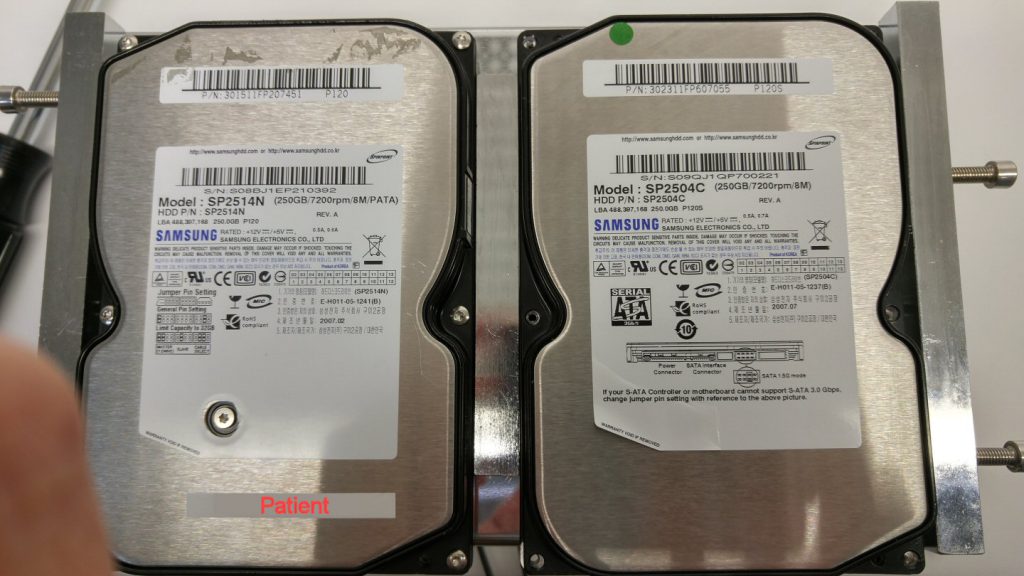This week’s special case was a 2007 PATA HDD. This Samsung SP2514N was in an external enclosure and got knocked over. Since the drive was identified as dropped and “previously opened” we first opened it in one of our laminar airflow workstations. Upon inspection we noticed a stiction mark on the top platter but the head was bent up. This can happen when someone follows one of the many do it yourself data recovery tips online. In this case, as in many, the heads were ripped from the platters. It’s always a gamble opening a hard drive because you might cause more damage and you will definitely introduce contamination. Unfortunately the solutions presented almost never mention the tolerances that modern HDDs work at. I think if people understood the head fly-height tolerances they would be less likely to open their own hard drive, assuming the data is important.
- .0038μm Modern head flying height
- 4.00μm Fingerprint
- 10.00μm Dust Particle
- 75.00μm Human Hair
Usually when we receive a stiction case, where the heads are literally stuck to the platter, we can use special tools and/or procedures to un-stick the heads. In some of these cases we can even recover data without changing the head stack assembly, which saves the customer money. Once the heads were ripped from the platter we had no choice but to perform a head swap.
In many cases we already have a compatible donor drive for heads even for a 10 year old PATA HDD. When sourcing a donor drive we have to match certain criteria so the heads and preamp will work in our patient drive. There are some companies that know how important a matching head stack assembly is so they have created a business model for stocking (hoarding) hard drives and charging extremely high prices for them (scalping). It’s not unusual for a DR company to pay $200+ for 1 used hard drive needed to complete a recovery case. In the case of this older model Samsung PATA drive there were some compatible donors at a popular donor drive website for around $89, which was not bad considering some prices we have been subjected to. Sometimes Ebay is a little cheaper for sourcing donor drives but in this case there were only 2 listed for around $120 each. That’s where experience and testing comes in to play. From our own testing and experience we knew that the SATA counterpart to the SP2514N is the Samsung SP2504C 250GB SATA hard drive.
 Fortunately, there are more Samsung SP2504C SATA drives available than the PATA drive and at much lower costs. That’s another victory for keeping data recovery prices affordable!
Fortunately, there are more Samsung SP2504C SATA drives available than the PATA drive and at much lower costs. That’s another victory for keeping data recovery prices affordable!
But wait! The drive didn’t work after the head swap. Here again experience can be the difference in success and failure. One might think the heads were not compatible but I already knew that wasn’t the case. There was no doubt in my mind that these heads were compatible. So what was it? Over time hard drives will develop some contamination on the PCB contacts for the head stack assembly. For some reason these old Samsung drives get some of the worst contact corrosion of any drive we have seen. In this case the contacts were literally black! The normal procedure of cleaning them with an eraser did not work. Even contact cleaner did nothing for this PCB. We actually had to scrape the contacts clean and tin them with flux and solder.
The data recovery business presents many challenges for numerous reasons. There are standard practices and procedures to follow but there are always cases where experience is the difference between cost, success, and failure. In the end the customer gets their data back and we keep offering affordable data recovery services.